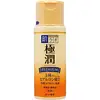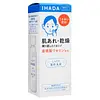What's inside
What's inside
 Key Ingredients
Key Ingredients

 Benefits
Benefits

 Concerns
Concerns

No concerns
 Ingredients Side-by-side
Ingredients Side-by-side

Tranexamic Acid
AstringentSodium Hyaluronate
HumectantHydrolyzed Hyaluronic Acid
Humectant3-O-Ethyl Ascorbic Acid
Skin ConditioningTocopherol
AntioxidantGlycerin
HumectantDiglycerin
HumectantDipropylene Glycol
HumectantSorbitol
HumectantPentylene Glycol
Skin ConditioningPPG-17 Butyl Ether
Skin ConditioningPolyglyceryl-10 Eicosanedioate/Tetradecanedioate
Skin ConditioningButylene Glycol
HumectantDiethoxyethyl Succinate
SolventPolyglyceryl-2 Hydroxypropyl Ethylhexyl Ether
CleansingSqualane
EmollientC4-18 Alkyl Methacrylate/Methacryloyloxyethyl Phosphorylcholine Copolymer
HumectantPetrolatum
EmollientCetearyl Alcohol
EmollientBehenyl Alcohol
EmollientXanthan Gum
EmulsifyingAcrylic Acid/C12-22 Alkyl Acrylate Copolymer
StabilisingPolyvinylalcohol Crosspolymer
PEG-20 Sorbitan Isostearate
EmulsifyingGlyceryl Stearate
EmollientEDTA
Melaleuca Alternifolia Leaf Oil
AntioxidantSodium Metabisulfite
AntioxidantPhenoxyethanol
PreservativeIodopropynyl Butylcarbamate
PreservativeSodium Paraben
PreservativeTranexamic Acid, Sodium Hyaluronate, Hydrolyzed Hyaluronic Acid, 3-O-Ethyl Ascorbic Acid, Tocopherol, Glycerin, Diglycerin, Dipropylene Glycol, Sorbitol, Pentylene Glycol, PPG-17 Butyl Ether, Polyglyceryl-10 Eicosanedioate/Tetradecanedioate, Butylene Glycol, Diethoxyethyl Succinate, Polyglyceryl-2 Hydroxypropyl Ethylhexyl Ether, Squalane, C4-18 Alkyl Methacrylate/Methacryloyloxyethyl Phosphorylcholine Copolymer, Petrolatum, Cetearyl Alcohol, Behenyl Alcohol, Xanthan Gum, Acrylic Acid/C12-22 Alkyl Acrylate Copolymer, Polyvinylalcohol Crosspolymer, PEG-20 Sorbitan Isostearate, Glyceryl Stearate, EDTA, Melaleuca Alternifolia Leaf Oil, Sodium Metabisulfite, Phenoxyethanol, Iodopropynyl Butylcarbamate, Sodium Paraben
Allantoin
Skin ConditioningDipotassium Glycyrrhizate
HumectantWater
Skin ConditioningGlycerin
HumectantC20 Olefin
Dipropylene Glycol
HumectantButylene Glycol
HumectantPentaerythrityl Tetraethylhexanoate
EmollientGlyceryl Isostearate
EmollientPetrolatum
EmollientIsopropyl-Tetramethyl-Dioxane
PerfumingGlycol Stearate
EmollientBehenyl Alcohol
EmollientBatyl Alcohol
EmollientPolyvinylalcohol Crosspolymer
PEG/PPG-17/4 Dimethyl Ether
Skin ConditioningPotassium Hydroxide
BufferingXanthan Gum
EmulsifyingPhytosteryl/Octyldodecyl Lauroyl Glutamate
Skin ConditioningSodium Metaphosphate
BufferingSodium Metabisulfite
AntioxidantCalcium Chloride
AstringentMagnesium Chloride
Sodium Glutamate
MaskingSodium PCA
HumectantPhenoxyethanol
PreservativeAllantoin, Dipotassium Glycyrrhizate, Water, Glycerin, C20 Olefin, Dipropylene Glycol, Butylene Glycol, Pentaerythrityl Tetraethylhexanoate, Glyceryl Isostearate, Petrolatum, Isopropyl-Tetramethyl-Dioxane, Glycol Stearate, Behenyl Alcohol, Batyl Alcohol, Polyvinylalcohol Crosspolymer, PEG/PPG-17/4 Dimethyl Ether, Potassium Hydroxide, Xanthan Gum, Phytosteryl/Octyldodecyl Lauroyl Glutamate, Sodium Metaphosphate, Sodium Metabisulfite, Calcium Chloride, Magnesium Chloride, Sodium Glutamate, Sodium PCA, Phenoxyethanol
Ingredients Explained
These ingredients are found in both products.
Ingredients higher up in an ingredient list are typically present in a larger amount.
Behenyl Alcohol is a type of fatty alcohol (these are different from the drying, solvent alcohols).
Fatty Alcohols have hydrating properties and are most often used as an emollient or to thicken a product. They are usually derived from natural fats and oils; behenyl alcohol is derived from the fats of vegetable oils.
Emollients help keep your skin soft and hydrated by creating a film that traps moisture in.
In 2000, Behenyl Alcohol was approved by the US as medicine to reduce the duration of cold sores.
Learn more about Behenyl AlcoholButylene Glycol (or BG) is used within cosmetic products for a few different reasons:
Overall, Butylene Glycol is a safe and well-rounded ingredient that works well with other ingredients.
Though this ingredient works well with most skin types, some people with sensitive skin may experience a reaction such as allergic rashes, closed comedones, or itchiness.
Learn more about Butylene GlycolDipropylene Glycol is a synthetically created humectant, stabilizer, and solvent.
This ingredient helps:
Dipropylene glycol is technically an alcohol, but it belongs to the glycol family (often considered part of the ‘good’ alcohols). This means it is hydrating and gentle on skin unlike drying solvent alcohols like denatured alcohol.
As a masking agent, Dipropylene Glycol can be used to cover the smell of other ingredients. However, it does not have a scent.
Studies show Dipropylene Glycol is considered safe to use in skincare.
Learn more about Dipropylene GlycolGlycerin is already naturally found in your skin. It helps moisturize and protect your skin.
A study from 2016 found glycerin to be more effective as a humectant than AHAs and hyaluronic acid.
As a humectant, it helps the skin stay hydrated by pulling moisture to your skin. The low molecular weight of glycerin allows it to pull moisture into the deeper layers of your skin.
Hydrated skin improves your skin barrier; Your skin barrier helps protect against irritants and bacteria.
Glycerin has also been found to have antimicrobial and antiviral properties. Due to these properties, glycerin is often used in wound and burn treatments.
In cosmetics, glycerin is usually derived from plants such as soybean or palm. However, it can also be sourced from animals, such as tallow or animal fat.
This ingredient is organic, colorless, odorless, and non-toxic.
Glycerin is the name for this ingredient in American English. British English uses Glycerol/Glycerine.
Learn more about GlycerinPetrolatum is more commonly known as petroleum jelly. It is created by mixing waxes and mineral oils.
This ingredient is effective at reducing water loss by 99%. This is because it is an occlusive. Occlusives create a hydrophobic barrier on the skin to prevent evaporation. This property makes it great for hydrating dry skin.
Pro tip: Use occlusives, such as this ingredient, on damp skin for the best results.
The quality or origin of petrolatum is only known when disclosed by the brand. Most cosmetic petrolatum has gone through several purification stages.
Another benefit of occlusives is it protects your skin against infection or allergies.
Petrolatum may not be safe for fungal-acne. Studies show mineral oil / petroleum leads to the growth of M. Furfur, a type of yeast.
Learn more about PetrolatumPhenoxyethanol is a preservative that has germicide, antimicrobial, and aromatic properties. Studies show that phenoxyethanol can prevent microbial growth. By itself, it has a scent that is similar to that of a rose.
It's often used in formulations along with Caprylyl Glycol to preserve the shelf life of products.
We don't have a description for Polyvinylalcohol Crosspolymer yet.
Sodium metabisulfite is also known as Sodium Pyrosulfite. It is a preservative, antioxidant, and disinfectant.
As a preservative, it helps stabilize cosmetic formulas without affecting their color or scent.
Xanthan gum is used as a stabilizer and thickener within cosmetic products. It helps give products a sticky, thick feeling - preventing them from being too runny.
On the technical side of things, xanthan gum is a polysaccharide - a combination consisting of multiple sugar molecules bonded together.
Xanthan gum is a pretty common and great ingredient. It is a natural, non-toxic, non-irritating ingredient that is also commonly used in food products.
Learn more about Xanthan Gum